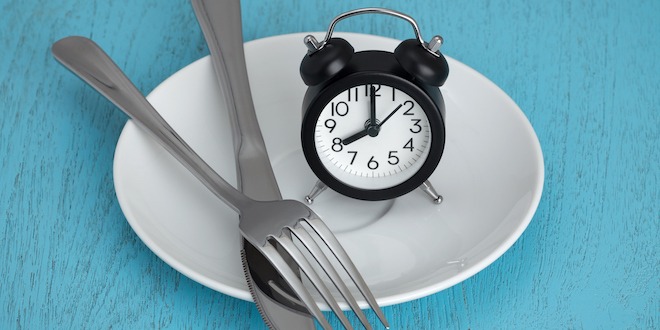What is intermittent fasting?
Intermittent fasting refers to an eating pattern that involves cycling between periods of eating and fasting. Intermittent fasting is less focused on which foods you eat, and more focused on when you eat.
There are several intermittent fasting methods, all of which split the day or week into eating periods and fasting periods.
16/8 fasting
With this option, you fast for 16 hours of the day and eat your meals during the other 8 hours. Since people already fast while they sleep, this method is popular and convenient. For example, you could skip breakfast, and then eat your first meal at 11:00 am or noon and your last meal at 7:00 or 8:00 pm.
Alternate day fasting
This method involves modified fasting every other day, in other words, limiting your food intake on fasting days to 500 calories, or about 25% of your normal intake. This approach usually includes one 200-calorie meal and one 300-calorie meal. It’s important to focus on foods that are high in fibre and protein to help fill you up, but to also keep calories low when fasting. On non-fasting days, you resume your regular, healthy diet. However, it’s important to know that one study investigating this method of intermittent fasting found that after six months, study participants had significantly increased low-density lipoprotein cholesterol levels (the “bad” cholesterol).
Twice-a-week fasting
This approach to intermittent fasting focuses on capping your calories at 500 for two days each week (rather than outright fasting). During the other five days of the week, you maintain a healthy and normal diet. You can choose whichever two fasting days are most convenient for you (for example, Tuesdays and Thursdays, or Wednesdays and Saturdays) as long as there is at least one non-fasting day between them.
24-hour fasting
This method involves fasting completely for an entire day, no more than once or twice a week. Most people fast from breakfast to breakfast or lunch to lunch. However, this method of intermittent fasting can cause extreme side effects, such as fatigue, headache and/or irritability. If you follow this method, you should be cautious of these side effects and ensure that you return to a normal, healthy diet on non-fasting days.
What are the benefits of intermittent fasting when living with diabetes?
The most commonly reported benefits among people with type 2 diabetes who practice intermittent fasting are:
- Weight loss
- Decreased levels of triglycerides (a fat found in the blood)
- Lowered blood pressure
- A reduction in insulin resistance
Researchers in New Zealand studied 41 people with type 2 diabetes who fasted twice per week for 12 weeks. At the end of the study, the participants had lost weight and also had lower A1C levels. However, increased episodes of hypoglycemia were also noted.
It’s important to note that there have been no large studies regarding the benefits (or harms) or intermittent fasting in people with diabetes.
Is intermittent fasting safe for people with diabetes?
Increased episodes of hypoglycemia (low blood sugar) pose as the biggest risk for people considering intermittent fasting. With no (or low) consumption of calories on fasting days, the chance of hypoglycemia is greatly increased. Diabetes researchers agree that people who choose intermittent fasting as a method of weight loss should work closely with their healthcare team to figure out how best to manage their diabetes medications on fasting days.
Is intermittent fasting right for me?
If you are considering intermittent fasting as a method of weight loss and to lower A1C levels, it’s important that you talk to your healthcare team beforehand. They can help you determine the right method of fasting for you, as well as assist with any medication adjustments that might be necessary on fasting days to ensure that you don’t suffer from episodes of hypoglycemia.
 Diabetes Care Community Learn, connect and care
Diabetes Care Community Learn, connect and care






